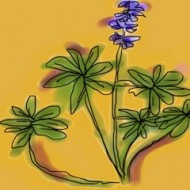Read me
It is fitting that the new issue of Pacific Horticulture should land in mailboxes during the Theodore Payne Foundation tour. As Los Angeles wakes up to native gardening, the latest edition of the magazine is a gentle reminder that its San Francisco-based publisher has long given indigenous flora equal weight with exotics. This issue is no different with looks at a xeriscape garden at Pitzer College, how to foster native bees (learn to love deadwood), a matured version of a cult native garden in Altadena and green roofs. The green roofs piece asks questions that Joseph Beuys admirers everywhere must have wondered at one point or another: What about weight? Drainage? What plants do best where? What happens when it gets dry? Do you have to water your roof?
This magazine is the thinking man’s Sunset. My only wish for it is an art director. The Western azalea blossom on …
The Dry Garden: Eco-snooping, part three
You might set out on the Theodore Payne Foundation tour this weekend for righteous reasons — to save water, or to help birds and butterflies. But the sheer beauty of Wynne Wilson’s Altadena home will have you wondering, why doesn’t everyone garden with natives? Her partnering of indigenous coral bells and lilac with the Mediterranean staples of citrus and lavender is so stupidly beautiful that you want to cry.
Click here for part three in the Los Angeles Times of The Dry Garden’s preview of this weekend’s Theodore Payne Foundation tour.…
Do nothing, do good
This 2009 photo by Allen J. Schaben of the Los Angeles Times captures the dynamics of Southern California's native watersheds in one shot, from snowcapped local mountains to the Pacific.
As a spring heat wave sends the snow on LA’s mountains gushing into the storm drain system, most of us can only dream of what the county would be like if its rivers and streams had not been channelized or buried. But rather than wait for a return to Eden, there are things that we can do to protect the Pacific as the snowmelt is plated out to sea.
That is goof off. …
Surrender Dorothy
Abandoned buildings in Pioche, Lincoln County, Nevada. The county partnered with Vidler Water Co. out of the belief that this would protect its groundwater reserves from predation by Las Vegas. Instead, Vidler partnered with Las Vegas and a massive private developer. The benefit to towns like Pioche, other than sharing water revenue with Vidler, remains unclear.
Talk about Westerns: Over the weekend, Henry Brean of the Las Vegas Review Journal, dusted down a honey of a grudge match.
It’s in Nevada, and Nevada being the driest state in the union, it’s about water.
To the south, we have Patricia Mulroy, the blonde general manager of the Southern Nevada Water Authority, who formed her agency expressly around the idea of building a nearly 300-mile-long pipeline into the wild heart of the state to sustain otherwise impossible growth around Las Vegas.
To the north, there is the brunette. Dorothy Timian-Palmer, …
The Dry Garden: Eco-snooping, part two
It was a hybrid call of the wild that Gilda Garcia heard when she decided to do a native garden in the frontyard of her North Hollywood home in 2006. As she recalled it during a mid-March visit, “The challenge was how could you mix native plants, Mexican art and poodles?”
It would be a spoiler to use anything but a detail shot from what is a truly fabulous before-and-after photo spread put together by Garcia and Los Angeles Times photographer Anne Cusack for this week’s “The Dry Garden” column.
So, click here to see how Garcia transformed her garden from lawn and three hedges into “Poodleville” in the Los Angeles Times and to read the second installment of the three-part series previewing properties on the Theodore Payne Foundation Tour, April 10-11.…
« go back — keep looking »

